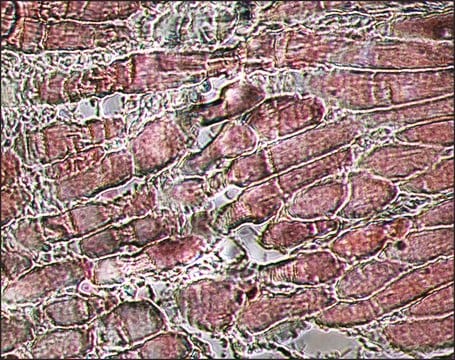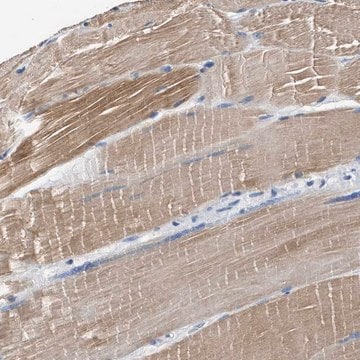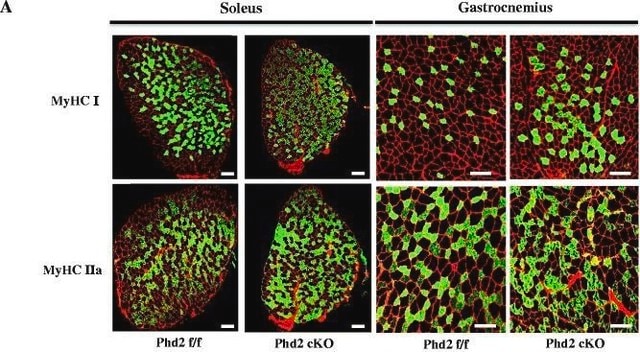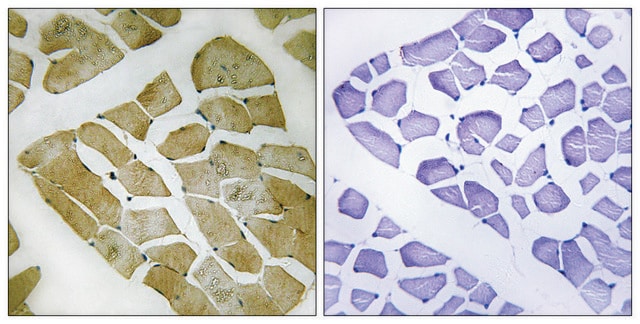Kluczowe dokumenty
M1570
Anti-MYH-1 Antibody

mouse monoclonal, MY-32
Synonim(y):
Monoclonal Anti-Myosin (Skeletal, Fast) antibody produced in mouse
Wybierz wielkość
697,00 zł
Wybierz wielkość
About This Item
697,00 zł
Polecane produkty
Nazwa produktu
Anti-Myosin (Skeletal, Fast) antibody, Mouse monoclonal, clone MY-32, purified from hybridoma cell culture
pochodzenie biologiczne
mouse
Poziom jakości
białko sprzężone
unconjugated
forma przeciwciała
purified immunoglobulin
rodzaj przeciwciała
primary antibodies
klon
MY-32, monoclonal
Formularz
buffered aqueous solution
reaktywność gatunkowa
rat, chicken, rabbit, mouse, human, bovine, guinea pig, feline
opakowanie
antibody small pack of 25 μL
rozszerzona walidacja
independent
Learn more about Antibody Enhanced Validation
stężenie
~1.0 mg/mL
metody
immunohistochemistry (formalin-fixed, paraffin-embedded sections): 10-20 μg/mL using porcine tongue
microarray: suitable
western blot: 0.5-1.0 μg/mL using total extract of rabbit skeletal muscle
izotyp
IgG1
numer dostępu UniProt
Warunki transportu
dry ice
temp. przechowywania
−20°C
docelowa modyfikacja potranslacyjna
unmodified
informacje o genach
human ... MYH1(4619) , MYH2(4620)
mouse ... Myh1(17879) , Myh2(17882)
rat ... Myh1(287408) , Myh2(691644)
Szukasz podobnych produktów? Odwiedź Przewodnik dotyczący porównywania produktów
Powiązane kategorie
Opis ogólny
Immunogen
Zastosowanie
Immunohistochemistry (1 paper)
Postać fizyczna
Oświadczenie o zrzeczeniu się odpowiedzialności
Nie możesz znaleźć właściwego produktu?
Wypróbuj nasz Narzędzie selektora produktów.
polecane
Kod klasy składowania
10 - Combustible liquids
Klasa zagrożenia wodnego (WGK)
WGK 1
Wybierz jedną z najnowszych wersji:
Certyfikaty analizy (CoA)
Nie widzisz odpowiedniej wersji?
Jeśli potrzebujesz konkretnej wersji, możesz wyszukać konkretny certyfikat według numeru partii lub serii.
Masz już ten produkt?
Dokumenty związane z niedawno zakupionymi produktami zostały zamieszczone w Bibliotece dokumentów.
Klienci oglądali również te produkty
Active Filters
Nasz zespół naukowców ma doświadczenie we wszystkich obszarach badań, w tym w naukach przyrodniczych, materiałoznawstwie, syntezie chemicznej, chromatografii, analityce i wielu innych dziedzinach.
Skontaktuj się z zespołem ds. pomocy technicznej
















